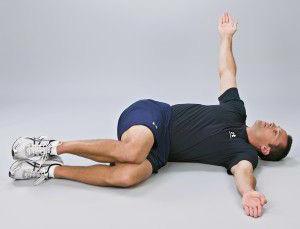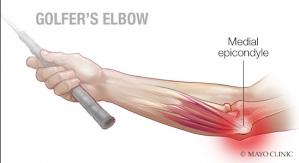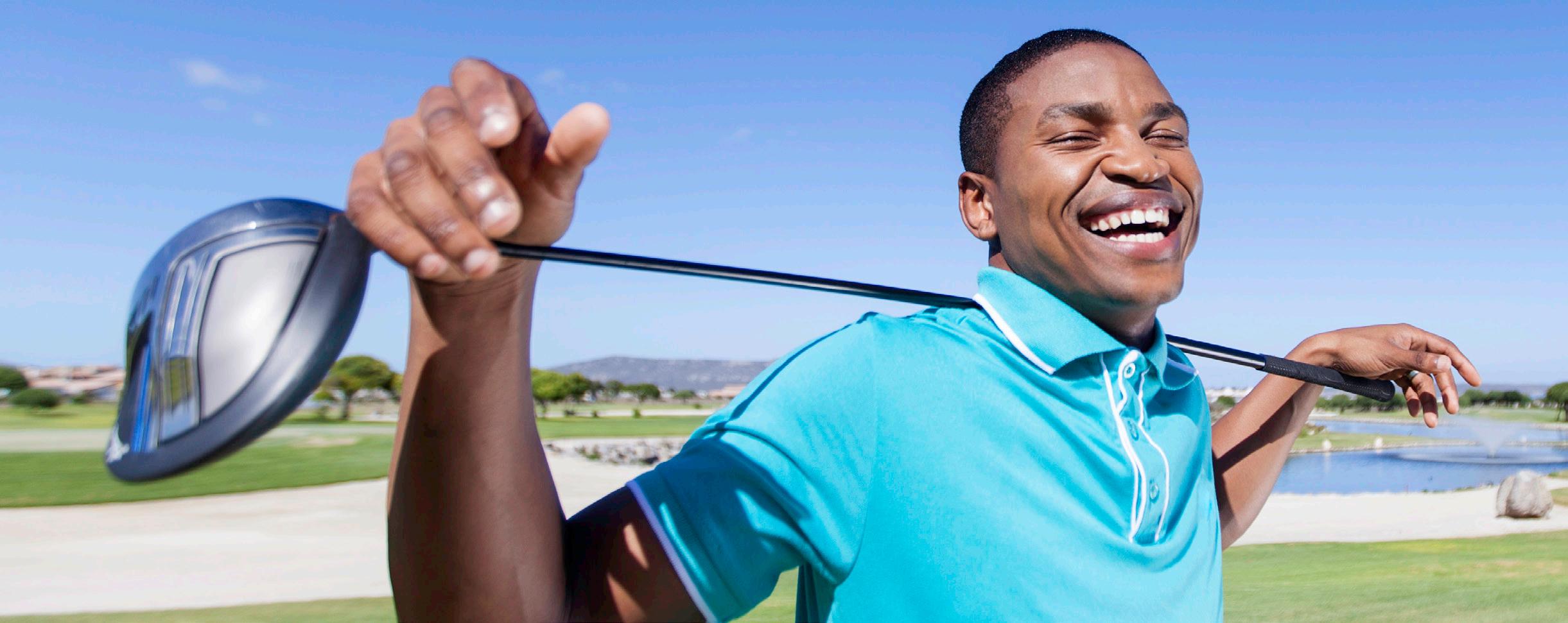
8 minute read
GOLF WELLNESS
WITH
BY EMMA COLEMAN OF SSM HEALTH
Common Injuries
Avoid golf’s most common injuries with these tips and treatments
Golf is at and all-time high in participation and media coverage at the amateur level — in part due to its socially-distant nature and accessibility. It’s a life-long leisure sport, which explains why it is so popular with kids and adults — and encourages interaction while you play. It's a great low-impact choice as it puts everyone outdoors and everyone can play golf.
However, as with any sport, injuries can happen. Golfers are especially prone to injury because of the repetitive motions required to swing the club. According to an article published in the British Journal of Sports Medicine, 60 percent of amateur golfers are injured at least once. Occasionally acute, traumatic injuries occur on the course, but nearly half of injuries (44 percent) are caused by repetitive movements and overuse. SSM Health lists the following prevention steps and awareness tips to stay healthy, be proactive and avoid injuries before you play and start swinging away.
EMMA COLEMAN MBA, ATC, is an Outreach Liaison for SSM Health Sports Medicine. She connects athletes of all levels in the community with injury prevention information and specialty services offered by SSM Health Sports Medicine. For more information, visit ssmhealth.com/ sports-medicine.
Warming up your muscles and joints is key to preventing injury in golf. Your warm-up should include stretches to loosen and warm the muscles in the neck, shoulders, back, and legs to increase mobility.
Incorporate these stretches into your golf warm-up:
Low back stretch
Lie on your back with your bent knees together. Slowly rotate your knees to one side so that your legs are parallel to the ground. Hold for 30 seconds and then return your knees to neutral. Slowly rotate your knees to the other side and hold for 30 seconds. Repeat a few times on both sides. Breathe while you stretch.

Neck stretch
Do the following movements and hold each stretch for 10-20 seconds. Look up, look down, look left, look right, and tilt your head each direction so your ear is almost touching your shoulder. Breathe while you stretch.
Shoulder stretch
Cross one arm over your body and hold with the opposite hand. Hold for 30 seconds and breathe. Repeat on the opposite side.
Hamstring stretch
Stand with your legs straight and slowly bend forward at the waist so you feel a stretch in your hamstrings. Do this with a wide stance first and then a narrow stance.
Take a few leisure swings with your golf club in hand to slowly prepare your body for the movements. A good warm-up should take about 10 minutes to complete, and should be done right before you walk to the first tee.
Back pain is the most common complaint among golfers. The mechanics that go into a golf swing affect the lower back for amateur and professional players. Aches in the back muscles usually start during or just after the activity — all related to tension, overuse, or injury of specific muscles.
Muscle aches and pains are common and can involve more than one muscle and other soft tissues such as ligaments, tendons, and fascia. However, low back pain also can be attributed to arthritis, spinal disc issues, and spinal stress fractures. Low back pain among golfers typically can be resolved with rest, physical therapy, or other orthopedic treatment. Stretching the lumbar spine and hips as described above will help to increase rotation in your swing and can help to prevent lower back pain.

Elbow injuries
Golfers are more likely to injure the tissues on the inside of the elbow, and this is called golfer’s elbow, or medial epicondylitis. Golfer’s elbow usually happens by striking the ground with the club during your swing.
Aside from pain, people who suffer from medial epicondylitis also may feel stiffness in their elbow or weakness in their hands or wrists. The nerves that run through this part of the elbow can be damaged, which causes numbness, tingling, or a pins-and-needles sensation (called paresthesia) in the hands or fingers.
Golfer’s elbow is similar to tennis elbow, or lateral epicondylitis, which happens on the outside of the elbow. Lateral epicondylitis is most commonly seen in racquet sports, but also is seen in golfers. Over-extending the elbow during your golf swing causes lateral epicondylitis .
Improving your swing technique can prevent both types of epicondylitis. Seeking help from a golf professional or a physical therapist can be beneficial in preventing elbow injuries during golf. To treat the pain and continue to golf, protect the elbow by stretching, using a brace, and icing after your round.
Shoulder pain
The shoulder is a highly mobile joint in the human body and the main hinge in the swing. The rotator cuff in the shoulder is made up of four muscles and tendons (subscapularis, supraspinatus, infraspinatus, and teres minor) that allow the shoulder its wide range of motion. Along with the rotator cuff muscles, the latissimus and pectoralis muscles also are used during the mechanics of a golf swing.
Any swelling, tearing, or bone changes, including arthritis, in the shoulder can cause pain when a person tries to move the arm in certain directions, especially repetitively as seen in a golf swing. Because both arms move uniquely in the swing, shoulder pain can alter your proper swing path. A good warm-up can help the range of motion in the shoulder and stabilize the core muscles, decreasing shoulder injuries.
Wrist injuries
Sprains and tendinitis are the most common wrist injuries for golfers. A sprain is an injury to the ligaments around a joint, which are the strong, flexible fibers that hold our bones together. When a ligament is stretched too far or it tears, the joint swells and becomes painful. Tendinitis is the inflammation, irritation, or swelling of a tendon, which is the connective tissue between a muscle and a bone. A tendon injury may progress to tendinosis (tendon degeneration), which can be a real obstacle for a golfer — and a constant irritant.
Another common wrist injury is fracture of the hamate bone. Many pro golfers, such as Ryan Moore in recent years, have brought this injury to light. The hamate is the small bone on the pinky side of the wrist. It has a small prominence called the hook, which juts into the palm. The way most golfers grip their clubs puts the butt-end of the club right up against the hook of the hamate during their swing. Breaking the hamate or hook can sideline a golfer extendedly.
Other injuries that occur during golf can be environmental rather than mechanical. These are just as important to think about before a round of golf.
Prevent sunburn on the course by applying generous amounts of sunscreen with a sun protection factor (SPF) of at least 30. Pay special attention to your face, nose, ears, and arms. The higher the SPF number, the greater the protection provided. Apply sunscreen 30 minutes before sun exposure, and reapply every two hours while you are outdoors. Wear a hat or SPF clothing to limit sun exposure as well — and don’t forget lip balm. Choosing a lip balm with sunscreen is important while golfing because the lips are highly sensitive to ultraviolet (UV) rays from the sun and are rarely covered with the brim of a hat.
While golfing in hot weather, watch for signs and symptoms of dehydration, heat exhaustion, and heatstroke. Heat-related injury can be serious, so stay hydrated by drinking plenty of water throughout your round, whether you feel thirsty or not. Heat injury warning signs include: (Sweating more than normal • Clammy skin • Fast, weak pulse • Nausea and/or vomiting • Muscle cramps • Feeling tired or weak • Dizziness • Headache)
If heat-related illness is suspected, get medical help and move to a cooler place.
Golf is an amazing sport for all ages and abilities, so be sure to take care of yourself on the course — it’s a sport for life. Follow these tips and listen to your body — your health and mindfulness can lower your scores.

Injury Treatment — use the PRICE Method
If you have just suffered an injury, the most common practice for treatment is using the PRICE Method.
P: PROTECT the injury from further harm by using a brace, splint, immobilizer, or ACE bandage. R: REST the injured area by avoiding activities that are painful to perform until it has had time to heal. I: ICE the area for 20 minutes every two hours. C: COMPRESSION of the swelling by wrapping an ace bandage or compression wrap around the joint will limit any further inflammation. When wrapping the injured area, start at the furthest point away from the body and move towards the body. Be sure that you are not cutting off circulation. E: ELEVATION of the injured area above the level of the heart will keep blood flow from pooling in the injured area.
Get back

in the swing of things.
If an injury has taken you off the course, the SSM Health Sports Medicine team will help you get back to the game you love.
As the premier sports medicine provider in the St. Louis region, our elite team of physicians, certified athletic trainers, and physical therapists collaborate to provide exclusive, direct access to comprehensive medical care for athletes of all ages.
We work with SLUCare Physician Group of Saint Louis University, SSM Health Orthopedics, primary care, and physical therapy departments, as well as the physical medicine and rehab programs at SSM Health Saint Louis University Hospital, to ensure you receive the best care possible for your unique injury.
Get back in the swing of things visit ssmhealth.com/SportsMedicine to learn more or call our concierge line 24/7 at 833-776-7767.
©2021 SSM Health. All rights reserved. SPT-STL-21-960246 2/21

SSM Health Sports Medicine is proud to provide medical care for athletes of Saint Louis University, Fontbonne University, Harris-Stowe State University and St. Charles Community College.
All of our hospitals, doctor’s offices, and other facilities have implemented enhanced safety measures. These include requiring all individuals to be screened for symptoms and requiring face masks for all upon entry. This will ensure you and your family are protected every step of the way.










